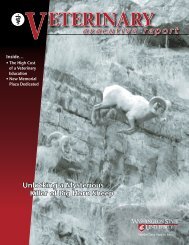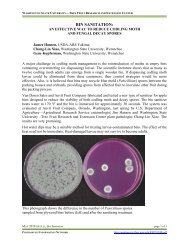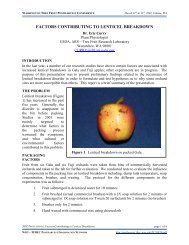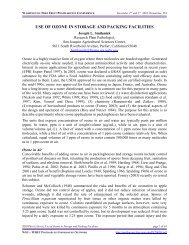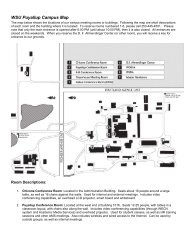2007 - Potatoes at WSU - Washington State University
2007 - Potatoes at WSU - Washington State University
2007 - Potatoes at WSU - Washington State University
You also want an ePaper? Increase the reach of your titles
YUMPU automatically turns print PDFs into web optimized ePapers that Google loves.
INTRODUCTION<br />
The <strong>2007</strong> <strong>Washington</strong> “Pot<strong>at</strong>o Cultivar Yield and Postharvest Quality Evalu<strong>at</strong>ions” annual report<br />
provides detailed inform<strong>at</strong>ion about promising new pot<strong>at</strong>o cultivars and how they compare to<br />
traditional reference varieties when grown in <strong>Washington</strong>. The d<strong>at</strong>a in this report are the result<br />
of intensive in-field and postharvest research conducted by the <strong>Washington</strong> St<strong>at</strong>e <strong>University</strong><br />
(<strong>WSU</strong>) Pot<strong>at</strong>o Variety Development Program. Our objective is to identify new pot<strong>at</strong>o varieties<br />
th<strong>at</strong> will provide profitable, sustainable production for the grower, improved competitiveness for<br />
the <strong>Washington</strong> pot<strong>at</strong>o industry, a healthy, inexpensive food supply for American consumers, and<br />
contributions towards a healthy environment.<br />
This book reports the results from five variety trials: Red and Specialty, Early-Harvest Tri-St<strong>at</strong>e,<br />
Early-Harvest Regional, L<strong>at</strong>e-Harvest Tri-St<strong>at</strong>e, and L<strong>at</strong>e-Harvest Regional. The Tri-St<strong>at</strong>e trials<br />
evalu<strong>at</strong>e the newest clones coming from the Tri-St<strong>at</strong>e program (<strong>Washington</strong>, Oregon, and Idaho) and<br />
the Regional Trials evalu<strong>at</strong>e advanced clones th<strong>at</strong> have gradu<strong>at</strong>ed from the Tri-St<strong>at</strong>e in addition to<br />
advanced clones from other programs.<br />
The majority of the pot<strong>at</strong>o clones and cultivars evalu<strong>at</strong>ed in this report came from USDA/ARS<br />
funded breeding programs loc<strong>at</strong>ed <strong>at</strong> Aberdeen, ID and Prosser, WA. Additional clones and cultivars<br />
came from Oregon St<strong>at</strong>e <strong>University</strong>, Colorado St<strong>at</strong>e <strong>University</strong>, Texas A&M, North Dakota St<strong>at</strong>e<br />
<strong>University</strong>, <strong>University</strong> of Minnesota, USDA/ARS Beltsville, and Vauxhall, Alberta, Canada. The<br />
<strong>WSU</strong> Pot<strong>at</strong>o Variety Development Program is aided in research, administr<strong>at</strong>ive detail, and funding<br />
by the <strong>Washington</strong> St<strong>at</strong>e Pot<strong>at</strong>o Commission, the Northwest (Tri-St<strong>at</strong>e) Pot<strong>at</strong>o Variety Development<br />
Program (Idaho, Oregon, and <strong>Washington</strong>, USDA/ARS), the Western Coordin<strong>at</strong>ing Committee 27<br />
(WERA-27), and other members of the U.S. pot<strong>at</strong>o industry.<br />
We do our best to provide meaningful inform<strong>at</strong>ion th<strong>at</strong> can be used by growers, processors, freshpack<br />
sheds, researchers, and other industry personnel. The results from this year’s trials are<br />
presented in “user-friendly” graphs, figures, and charts. An economic analysis was conducted on<br />
all clones and cultivars for both the fresh and process markets, with the exception of the red and<br />
specialty clones. We also provide a merit r<strong>at</strong>ing for each cultivar within a specific market. The<br />
cultivars are ranked according to their overall performance which takes into account economics,<br />
yields, tuber-size profiles, tuber quality and many post-harvest <strong>at</strong>tributes. It is our hope th<strong>at</strong> this<br />
report is useful and easy to understand.<br />
Accomplishments in <strong>2007</strong>:<br />
As a result of the Northwest Pot<strong>at</strong>o Variety Development Program’s efforts, more than 26 percent<br />
of the <strong>2007</strong> PNW acreage was planted with varieties released by the program. In <strong>Washington</strong> St<strong>at</strong>e<br />
alone, these varieties accounted for more than 32% of the <strong>2007</strong> acreage, with a farm-g<strong>at</strong>e value of<br />
approxim<strong>at</strong>ely $160,000,000. The increase in acreage devoted to NWPVD varieties has been 5-fold<br />
since 1997. Recent NWPVD releases, Ranger and Um<strong>at</strong>illa, have had a significant impact on the<br />
processing industry, accounting for 23% and 12% of WA processing pot<strong>at</strong>oes in <strong>2007</strong>, respectively.<br />
New NWPVD clones released this year include A84180-8 and A88338-1. More inform<strong>at</strong>ion is<br />
available for each clone <strong>at</strong>: www.pot<strong>at</strong>oes.wsu.edu.<br />
<strong>2007</strong> Pot<strong>at</strong>o Cultivar Evalu<strong>at</strong>ions 4 <strong>WSU</strong> Pot<strong>at</strong>o Research Group



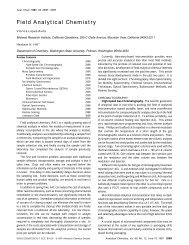
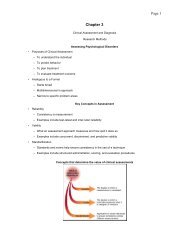


![Graduate School Policies & Procedures Manual 2011 - 2012 [PDF]](https://img.yumpu.com/50747405/1/190x245/graduate-school-policies-procedures-manual-2011-2012-pdf.jpg?quality=85)
